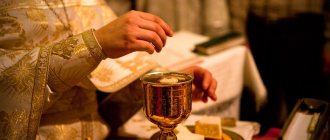Communion is an opportunity to feel unity with the Lord. Only baptized people are allowed to visit it. Three days before the sacrament, you need to start fasting and read prayers. People come to the cup after confession in the morning on an empty stomach. The believer receives the prosphora and places his lips on the cup. Relaxations apply to fasting for the sick, infirm and children under 7 years of age. You can take communion as often as your soul dictates.
It is very important for a Christian to know what communion is. After all, in fact, this is one of the key rituals of Christianity - it is found in Catholicism, Protestantism, the Orthodox, and most sects that have broken away from the main religion.
What is Communion
The first time the sacrament of communion was performed by Jesus Christ was during the Last Supper. Having broken the bread that was traditionally eaten on Passover, he divided it among the disciples and said: Take and eat, this is my body. Then he passed a cup of wine around with similar words: take it, drink, this is my blood. In two of the four Gospels the continuation follows: and do so further, in memory of me. Afterwards the ritual took hold. Communion in church has become one of the great rituals of Christianity, without which it would be unthinkable to imagine it.
Figure 2. Last Supper
Communion in the early church
How was communion administered in the early church? There is evidence that this was a very simple ceremony with bread and wine. All evidence indicates that communion took place every week on Sundays (or on Saturday evenings, since the day was counted from sunset to sunset, and not from 12 midnight to 12 midnight). Among other things, the early church ate communally, they called it “the feast of love,” but these feasts were separate from communion. There is evidence that the early church allowed only believers to receive communion, although it is possible that this was done more for safety reasons than for theology. So from a biblical perspective, it is an open question whether to invite non-believers to join in communion or not. The church I visit allows everyone to receive communion.
Preparation for the sacrament
You need to prepare for Communion several days in advance. If it is on Sunday, then from Friday. A strict fast is prescribed - without meat, milk, eggs, for those who want to truly understand the importance of the ritual, even without fish. You need to read the penitential canon to Jesus Christ, as well as the prayer canon to the Mother of God, and the simple canon to the Guardian Angel. Then - proceeding to holy communion. These prayers are traditional in Orthodoxy; in other variations of Christianity they are different.
Afterwards you need to go to the evening service on Saturday, confess, come home, have a sparing dinner and go to bed. You can’t eat anything in the morning—they approach the cup on an empty stomach.
It is important to know that women cannot receive communion during menstruation - this is a sin.
Fast
Everyone needs to fast. The severity and duration of fasting should be discussed with the spiritual leader.
Relaxations in fasting
Relaxations in fasting are acceptable for sick people and pregnant women. But, since strict fasting is not expected from the laity, you can try without them.
How does the sacrament work?
In the morning you need to come to the temple early, defend the liturgy, listen to the canon for those receiving communion. When the priest leaves the altar with the chalice, repeat the prayer after him. Afterwards, bow to the ground, cross your arms over your chest and come up to receive the gifts.
Each believer receives a piece, allows them to wipe their lips, kisses the edge of the bowl and goes to a special table where they can drink some juice and eat prosphora.
After the service is over, you should return home and maintain harmony with yourself and the world around you for as long as possible.
Figure 3. How the Communion ritual works
Piety, Communion and Coronavirus
Photo: Igor Ivanko/Moscow Agency The coronavirus epidemic has changed the usual course of life on almost all continents. It is quite natural that a discussion broke out among the Orthodox about what should be a person’s behavior in church and what should be the “technique” of communion so that the risk of infection does not push a person away from prayer and the sacrament of the Eucharist? The discussion in Russia can be called unexpected for two reasons.
Firstly, the discussion of the problem among the laity and priests looks much more meaningful both from theological and practical points of view than a dry statement from the official church authorities, which most closely resembles a bureaucratic reply.
Secondly, the parties to the discussion are not the usual conservatives and liberals. On opposite sides of the barricades were completely different groups that had not publicly expressed themselves before. On the one hand, these are educated laymen, monks and priests, who have become the main force of church revival, and on the other, uneducated ones, for whom all of Orthodoxy comes down to a kind of “spiritual first aid kit,” a fixed set of rules, where one question corresponds to only one correct answer. . According to the apt observation of theologian Vladimir Shmaliy, this long-standing conflict between “urban” and “rural” Orthodoxy has manifested itself so clearly and obviously for the first time.
Perhaps this is the most interesting thing in the ongoing discussion. The fact is that Orthodox piety
gradually turns into an independent religion. The Orthodox Church is one thing - with theological, historical, pastoral and ecclesiastical practical experience, and quite another thing are ordinary believers who are squeezed within the framework of a rather random set of mythologies and church rules. Both rules and mythologies seem to them completely unshakable, almost holy. Therefore, talking about any changes - even if there is a threat of an epidemic - indicates only one thing: the weakness of faith and nothing else. Nothing can be changed in Orthodoxy!
The second group offers a sober and realistic look at existing church practices. An epidemic is not only a threat as such, it is also a good incentive to critically evaluate existing practices, in this case not from a theological or historical, but from a purely practical point of view: what does not correspond to modern ideas about hygiene? What is the best way to protect parishioners from infection in churches? A calm and sober look allows you to see different opportunities for solving problems that have arisen.
There are three areas where you need to pay special attention. The threat of infection arises when transmitted:
- by airborne droplets;
- through contact: handshake and kiss;
- through the communion of the healthy and the sick with the same spoon.
Let's look at all these problems in order.
Photo: Sergey Kiselev/Moscow Agency
In the space of the temple
There are few large churches in Russia, so a temple is most often a small, enclosed and poorly ventilated room. Being near infected people during a two-hour service is already a serious threat. If an infected person coughs or sneezes, then everyone standing at a distance of up to three meters receives the virus from him, if not on the skin and mucous membranes, then on clothing, where the virus persists for many hours, and sometimes days.
What can be done? The recommendation of Tomas Pueyo, who created a mathematical model of the spread of the virus, is simple: churches should remain open as long as they guarantee a distance of at least one meter between worshipers.
This is a weak measure, and in the context of a growing epidemic, the Italian authorities simply closed all churches, offering to organize Internet broadcasts and watch them for parishioners without leaving their homes. The government's decision did not cause any protests. Moreover, all churches in Italy reacted to this ban with understanding.
The only one who tried to call the Orthodox to disobedience was Archpriest Dimitry Smirnov, one of the leaders of “village Orthodoxy” in Russia. “There is a point in the “Fundamentals of the Social Concept” about when people should show civil disobedience. In this case, if there is an order from the authorities, city or federal, about some actions that contradict our faith, we must ignore it,” he said on the Spas TV channel. To avoid conflict, he advised the Orthodox to gather for night services. “How can one not celebrate the Eucharist? The plague stopped when people began to take communion!” - he reminded. In his opinion, such bans indicate that “the government is completely godless” and “this is the beginning of the end.”
The words of Father Dimitri turned out to be at the very least irresponsible and could lead to serious consequences, since they directly provoked a conflict between the Russian Orthodox Church and the Italian government. The media took the priest’s words for quotes, but soon had to reverse the course: the recording of the broadcast was deleted from the official website of the TV channel without any comments, and even the reprint of his speech on Interfax was deleted; it can only be found in the Yandex cache.
Recommendations: try not to visit crowded churches, and people of the older generation should completely refrain from visiting churches during the epidemic. If you or your children are sick, avoid going to church for the duration of your illness. This is not weakness, but a conscious act for the safety of your neighbors. Let your home prayer be more intense these days.
Kissing icons, crosses, hands of priests
A handshake in church is most often combined with kissing, but kissing as worship is very widespread: this includes kissing icons, holy relics, kissing the edge of the Chalice after communion, kissing the cross after the Divine Liturgy, and simply kissing the priest’s hand during a blessing.
Kissing icons is a special case. For some, this is a mystical practice that they are not ready to give up, but most parishioners will say that this is a tradition that they follow, or even a habit. But for most parishioners, this is an important part of the standard (almost magical) ritual when visiting an Orthodox church. This simple ritual has a maximum of three components:
— write a note (by the way, pens are common - they write on everything and it’s unlikely that the temple staff will realize that they should be disinfected at least a couple of times a day); — buy candles; - kiss the icons and light candles in front of them.
To this day there are practically no restrictions on kissing icons, and, moreover, this measure is not even discussed.
The Cossacks showed unexpected sobriety. It would seem that they should be in the camp of “village Orthodoxy,” and the general rhetoric of their atamans, on the one hand, confirms this: “Cossacks, as warriors of Christ, are at the forefront in the fight against manifestations of the Forces of Darkness. Diseases, viruses - everything that leads to destruction - these are the tricks of Satan, and it is very important that the Church does not become a source of their spread,” says the statement of the Cossack Council of Atamans of Russia
But, on the other hand, the Cossack general from Yekaterinburg Gennady Kovalev quite calmly declared at the very beginning of March: “No kissing religious objects, until better times!” It is also necessary to bring the priests into a divine form - to oblige them to have medical books and undergo a medical examination... God forbid, someone there becomes infected, then people will completely stop going to churches. In Italy, churches are being checked and even closed for a while due to the epidemic, and rightly so. Maybe someone will condemn us for such a decision, but the Cossacks are independent people, we don’t look back at anyone.” And further the general expressed the hope that Rospotrebnadzor will check the sanitary condition of the churches.
The rules that the Greek Archdiocese in America published on March 6 look more systematic and consistent. These guidelines are based on guidelines from the US Centers for Disease Control. They are worth quoting in full:
1) All parishes will provide places in the vestibule and/or naos for believers to disinfect their hands upon entering the church. 2) Announcements will be posted at the entrance advising patients not to attend services but to participate on television or via the Internet. 3) Clergy will not offer their hands to be kissed and will refrain from shaking hands or hugging the faithful. 4) Notices will be posted recommending that the cross and icons be honored by bowing, and not by kissing. 5) No books, liturgical or Bibles, will be issued. Congregants will be encouraged to bring their own books from home. 6) Believers will not receive Antidor from the hands of the clergy, but will take it themselves when leaving the church. 7) In the case of the use of flowers (Resurrection of the Cross, Palm Sunday, Good Friday), Believers will take them themselves when leaving the church. On Holy Wednesday (Holy Anointing), each priest will anoint each believer using separate cotton swabs. Communion will be taught as usual. 9) During concelebrations, the “kiss of peace” between clergy will be carried out through bows to each other. In parishes where the laity exchange the "kiss of peace", they will also avoid contact by bowing to each other. 10) After each service, all liturgical objects and surfaces must be thoroughly cleaned.
2) Announcements will be posted at the entrance advising patients not to attend services but to participate on television or via the Internet. 3) Clergy will not offer their hands to be kissed and will refrain from shaking hands or hugging the faithful. 4) Notices will be posted recommending that the cross and icons be honored by bowing, and not by kissing. 5) No books, liturgical or Bibles, will be issued. Congregants will be encouraged to bring their own books from home. 6) Believers will not receive Antidor from the hands of the clergy, but will take it themselves when leaving the church. 7) In the case of the use of flowers (Resurrection of the Cross, Palm Sunday, Good Friday), Believers will take them themselves when leaving the church. On Holy Wednesday (Holy Anointing), each priest will anoint each believer using separate cotton swabs. Communion will be taught as usual. 9) During concelebrations, the “kiss of peace” between clergy will be carried out through bows to each other. In parishes where the laity exchange the "kiss of peace", they will also avoid contact by bowing to each other. 10) After each service, all liturgical objects and surfaces must be thoroughly cleaned.
At the same time, the Greek tradition has long been different from the Russian one: a common cloth is not used for the obligatory wiping of the mouth after communion, there is no kissing of the edge of the Chalice, but more on this a little later.
Rospotrebnadzor has not issued any instructions for religious organizations, so the position of the Russian Orthodox Church appears in stark contrast. The Synod of the Russian Orthodox Church did not see any problems with the established practices of kissing the hands of priests and icons during the epidemic and limited its statement to general and rather dry words about “consistent and strict observance of sanitary and hygienic measures of a preventive nature in parishes and monasteries, especially in those regions where where the epidemiological situation is officially recognized as difficult, including the wider use of sanitary solutions to disinfect the icon shrines to which believers venerate.”
Only one Ukrainian bishop, Metropolitan Jonathan of Tulchin and Bratslav, issued clear instructions on how parishioners should change their behavior in church:
“I, unworthy, bless the Tulchin diocesan flock, if such a need comes, until the danger of the coronavirus epidemic completely disappears, to venerate the shrines “in Greek” - through the “kissing” of the aer
, - respectively, away from the glass of the icon case, and greet each other with an “airy” (non-contact) bow. Our responsibility for the lives and health of our elderly parishioners, relatives and friends tells us to do this temporarily. For God protects those who are protected! I draw the attention of confessors to this: one should confess in such a way that one should not bow one’s head under the epitrachelion, but stand with only one ear bent towards the penitent, in order to hear his confession.”
But this is just one of several hundred bishops of the Russian Orthodox Church. The rest are silent.
Recommendations: It’s okay if you temporarily give up kissing icons, the cross, the hands of priests and each other and replace this kissing with a reverent bow from the waist or bowing your head.
Photo: Anton Kardashov/Moscow Agency
Communion
We are approaching the most difficult and most delicate issue - about Communion. A separate article would need to be written here, but for now I’ll have to limit myself to a few brief theses.
The Chalice contains the Body and Blood of Christ. And this shrine is taught to all Orthodox Christians as a guarantee of eternal life. In St. Gifts are the fullness of the life to which we strive, and therefore there can be nothing defective, disease-causing or deadly in them. This is how the Church believes, and this is how everyone who approaches the Chalice believes. There is no doubt about it.
Priests who serve in prisons and tuberculosis hospitals are sure: it is impossible to become infected while taking the sacrament, even if you take the sacrament together with infectious patients. They say that everything is done by faith: “According to your faith be it done to you” (Matthew 9:29). I recently came across the most radical formulation in one of the Internet discussions: if you believe and are not afraid to die, then you receive communion; If you are afraid to die, then do not take communion. However, this approach looks like overt blackmail. If you take communion and don’t get sick, it means you have strong faith. And if you get sick after visiting the temple, then it’s your own fault—this is confirmation of your lack of faith.
However, even the Church in Byzantium, having abandoned the 7th-8th century from distributing the sacrament into the hands of believers (this practice was preserved in the West) and introducing a spoon in order to place the sacrament in the mouth, formed special rules for communion during epidemics.
A rather unexpected interpretation of the 28th rule of the VI Ecumenical Council is given by the Monk Nicodemus the Holy Mountain,1 who lived in the second half of the 18th century. Apparently, he survived the plague epidemic that began in the Ottoman Empire in the late 1760s and came to Russia in 1771. Nicodemus writes very progressively for his time:
“Both priests and bishops during the plague should use a method for giving communion to the sick that does not contradict this rule. They must put the Holy Bread not in grapes, but in some sacred vessel, from which gravediggers and the sick can take it with a spoon. The vessel and spoon should then be immersed in vinegar, and the vinegar poured into the altar well. Or they can give communion in any other, more reliable way that does not violate the rule.”
Yes, today we know that this measure could not prevent the spread of the plague. Its main carriers are fleas, but what is important here is that the Church thought about how established practices could be changed during an epidemic.
Naturally, these practices developed, and here is what S. V. Bulgakov writes in 1892 in “A Handbook for Clergy and Church Ministers”:
“After giving communion to a sick baby, in order to prevent infection of the next communicant, one should firmly wipe with the Holy Intercession. liar. If a contagious disease appears in the parish, for example, diphtheria, smallpox, which can easily spread to others during communion through a spoon and a cover, parishioners should be advised not to bring sick children to church at all
(hereinafter italics are mine. -
Author's note
);
in extreme cases, those sick with an infectious disease should be given communion after the healthy ones and both the spoon and the child’s mouth should be wiped with a special piece of clean linen, burning it after communion
.”
In the twentieth century, a practice more in line with modern ideas about hygiene spread in the Churches of the Greek tradition: a particle of St. The communicant himself does not take the gift from the spoon, licking it, but the priest “throws” this particle into the communicant’s mouth so that no one touches the spoon itself with his lips. In addition, the Greeks do not have a mandatory rule of kissing the edge of the chalice and the deacon or altar server does not wipe the lips of all communicants with one cloth.
There is no drinking in Greek temples, but in Russian churches outside Russia, where the same practice is followed, disposable cups are used. It must be said that in Russia there are churches where they are used, but be careful: too often they turn into reusable ones.
In one of the Russian monasteries they are already thinking about how to disinfect the spoon after each communicant, and they say that this can be done either with alcohol, wetting part of the plate with it, or with boiling water, if the altar boy stands next to the communing priest and holds a thermos with boiling water.
Unexpectedly, I would even say, the already mentioned Metropolitan Jonathan spoke out very radically:
“As for the image of partaking of the Body and Blood of the Lamb of God - under the guise of Bread and Wine - and the consumption of the remaining Holy Gifts by the clergy, then everything should be left for now according to the custom of the Orthodox Church.
In the event of a dangerous, widespread spread of coronavirus in our region, which must be reported by official authorities and medical workers, out of condescension to the wishes of some, I bless them to receive communion in the same way as in ancient times all Christians received communion in churches - in the manner of the teaching of the Holy Gifts at the liturgy Holy Apostle James - separately.
At the same time, place the Body of Christ in the hands of the communicants
. (In some Churches of Antioch (Syria), the Eucharistic bread is cut into “straws”, its edge is slightly dipped into a cup of Eucharistic Wine and then taught to the communicants.) The Blood of Christ can be taught by mouth from metal or disposable spoons, which the communicants bring with them. In addition, it would be good for them to have with them disposable containers (glasses) for drinking water mixed with wine after communion, and clean cloths or napkins to dry their lips with.”
That is, the hierarch admits that communion can be without the usual lie as such.
And just before submitting the article to the editor, I received a message that in one of the Orthodox churches in Belgium they began to give communion with disposable spoons.
In several other countries, authorities followed the example of Italy and asked to close churches during the epidemic.
Recommendations: The epidemic is a reason to intensify prayers and be more attentive to your neighbors. If you have the opportunity to participate in worship in a church where they took the epidemic seriously and took safety measures, then there is no reason to avoid visiting the church. If the church pays no attention to hygiene problems, then there is nothing wrong with the fact that during an epidemic you decide not to participate in the liturgy. Today in the Orthodox Church there are no rules regulating the frequency/regularity of communion. This is your decision, your personal choice. No one will force you to take communion and, conversely, no one will force you to refuse communion.
The fact that even in large churches they have not yet realized the seriousness of the situation is evidenced by a report on the stay of the ark with the relics of John the Baptist in St. Petersburg. Hundreds of people stand in line to see the relics, but not every time a volunteer wipes the glass covering the relics. But if next to the relics there is at least an employee who should do this, then next to the Kazan Icon of the Mother of God there is a stream of people applying to the icon, but, according to the authors of the report, no one wipes the glass of the icon case. Judging by the conversations, not all Orthodox Christians in St. Petersburg believe that the coronavirus exists.
* * *
Not everything in the Orthodox Church is uniform or monolithic. There is a whole range of practices, and some of them parishes can freely change themselves (for example, parishioners asked and the priest agreed), some - in agreement with the bishop (this applies primarily to forms of communion for the laity). The situation is not at all hopeless, unless you lock yourself in the circle of magical ideas about Orthodoxy. Society will change after the coronavirus epidemic. The Church will also change, but most likely these changes will be slower.
__________________________
1 Venerable Nicodemus the Holy Mountain. Pidalion: Rules of the Orthodox Church with interpretations. In 4 vols. - Ekaterinburg: Publishing House of the Alexander Nevsky Novo-Tikhvin Monastery, 2022. - vol. 2, p. 240.
Ritual for children and the sick
Figure 4. The priest gives communion to the sick
It is recommended that baptized children be brought to communion more often; fortunately, until the age of seven, children do not have to fast or go to confession. The only thing the canon requires of them is to read a few familiar prayers and not eat anything since midnight. The same rules apply for teenagers as for adults.
It is similar with the sick - if a person is on the verge of death, no one demands that he fast. He does not have to go to a cathedral or temple - the priest himself can come to his bedside, confess and give him communion.
On Christmastide, Communion is carried out according to the usual procedure. The week after Easter is special - you don’t have to fast during it.
Practice in the Modern Church
This is what I think we should do at communion in church today. We don't need "priests" to receive communion. We don't need special ceremonies or prescribed words. We don't see this in the history of the early church, just as we don't see it in the Bible. At the church I'm a part of, we have a simple ceremony that happens every week. We share bread and wine (or grape juice) with each other. We encourage people to remember the death, burial and resurrection of Christ. We hope this does not become just a meaningless tradition or habit. For this reason, usually one of the brothers will give a short teaching from the Bible to help focus the communion.
Some churches create entire ceremonies around communion. Some teach that only "priests" can perform this ceremony. Some teach that communion (they call it the Eucharist) is a reenactment of Christ's sacrifice. Some even take Christ's words "this is My body" and "this is My blood" literally and believe that when the priest performs the ceremony, the bread and blood literally change their structure, becoming the flesh and blood of Christ. But this is a theological error. I assume that you are attending a church where communion is administered much as it was done in the early church and as described in the Bible.
Final required parameters
Having analyzed the requirements for church wine, we can identify several parameters that Cahors must meet:
- absence of alcohol and flavorings;
- production from natural grape juice;
- the presence of a thick consistency and rich red or burgundy color;
- pleasant sweet taste.
Additional selection tips
If it is not possible to prepare church wine for the Eucharist and other religious rites yourself, when buying Cahors you should pay attention to the following points:
- Manufacturer's reputation. You should not buy wine from unknown brands; there are brands on the market that have proven themselves well, so you should give preference to them.
- Compound. The Cahors label usually indicates what the drink is made from. The composition should not contain flavorings, chemical additives or flavor enhancers.
You should also not purchase Cahors Cahors for church services in cardboard packs.
How often can you take communion?
The ritual must be performed when the soul desires it, when there is an internal need. The number of sacraments is not regulated by representatives of the Patriarchate. Most believers receive communion once or twice a month. The ritual is necessary for special occasions - weddings, baptisms, name days, and during great holidays. The only restriction is the ban on communion more than once a day. The holy gifts are served from two church vessels; you only need to try from one.
Is it possible for a non-Christian to receive communion in church?
Whether those who have not yet become Christians can take part in communion in church, we cannot know for sure, because... there are no direct passages from the Bible on this topic. This is a gray area and the answer depends on people's opinions. We know from the practice of the early church that at the end of the first century those who were not part of the church were not allowed to receive communion. But we have no direct evidence about this. So, although the example of the early church shows that it was inclined to exclude the unbaptized from communion, the evidence that the unbaptized can take part in communion is very strong.









